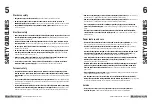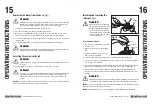
DIGITAL PLUNGE ROUTER - 054-6902-0
DIGITAL PLUNGE ROUTER - 054-6902-0
27
28
Edging with a pilot bit
(figs 12
and 12a)
WARNING!
Always securely clamp your workpiece
and keep a firm grip on the router
base with both hands at all times.
Failure to do so could result in loss
of control causing possible serious
personal injury.
Arbor-type bits with pilots are excellent for edge shaping
any workpiece edge that is straight or that is curved at
a curvature as great as or greater than the radius of the
bit to be used. The pilot prevents the bit from making an
excessively deep cut; holding the pilot firmly in contact
with the workpiece edge throughout prevents the cut from
becoming too shallow.
Whenever the workpiece thickness, together with
the desired depth of cut (as adjusted by the router
depth setting) are such that only the top part of
the edge is to be shaped (leaving at least a 1/16" thick uncut portion at the bottom), the pilot can ride
against the uncut portion, which serves to guide it (see fig 12).
If the workpiece is too thin or if the bit is set so low that there will be no uncut edge against which to
ride the pilot, an extra board to must be placed under the workpiece to act as a guide (see fig 12a). This
“guide” board must have exactly the same contour - straight or curved - as the workpiece edge. If it is
positioned so that its edge is flush with the workpiece edge, the bit will make a full cut (in as far as the bit
radius). If the guide is positioned as shown in fig 12a (extending beyond the workpiece edge), the bit will
make less than a full cut, which will alter the shape of the finished edge.
NOTICE:
The size (diameter) of the pilot that is used determines the maximum cut width that can be made
with the pilot against the workpiece edge (the small pilot exposes all of the bit; the large one reduces this
amount by 1/16"). Any of the piloted cutter bits can be used without a pilot for edge shaping with guides.
Feeding the router
(fig 13)
WARNING!
Always securely clamp the workpiece in place, and keep a firm grip on the router base
with both hands at all times. Failure to do so could result in loss of control causing possible
serious personal injury.
fig 13
ROUTER FEED
ROUTER FEED
ROUTER
END
GRAINS
FIRST
ROUTER FEED
ROUTER FEED
DIRECTION
DIRECTION
CUTTER BIT
DIRECTION
BIT
ROTATION
DIRECTION
The secrets to professional routing are making a careful set-up for the cut, selecting the proper depth of cut,
knowing how the cutter bit reacts in your workpiece, and the rate and direction of feed of the router.
Direction of feed - external cuts
The router motor and cutter bit rotate clockwise. This requires the feed of the cutter bit to be from left
to right (see fig 13). Feeding the bit from left to right will cause the bit to pull the router towards (up
against) the workpiece.
If the router is fed in the opposite direction (right to left), the rotating force of the cutter bit will tend to
throw the bit away from the workpiece, making it hard to control; this is called “Climb-Cutting”; cutting
in the opposite direction of the proper feed direction.
OPERA
TING INSTR
UCTIONS
OPERA
TING INSTR
UCTIONS
fig 12
Spindle
Lock
Motor Housing
Spindle
Collet/Nut
Fixed Base
Cutter-bit
TOP EDGE SHAPING
Pilot
Workpiece
Top Edge of
Workpiece
fig 12a
Workpiece
Guide
Board
Whole Edge of
Workpiece
WHOLE EDGE SHAPING
Содержание 054-6902-0
Страница 1: ...INSTRUCTION MANUAL DIGITAL PLUNGE ROUTER 054 6902 0...
Страница 24: ......










































